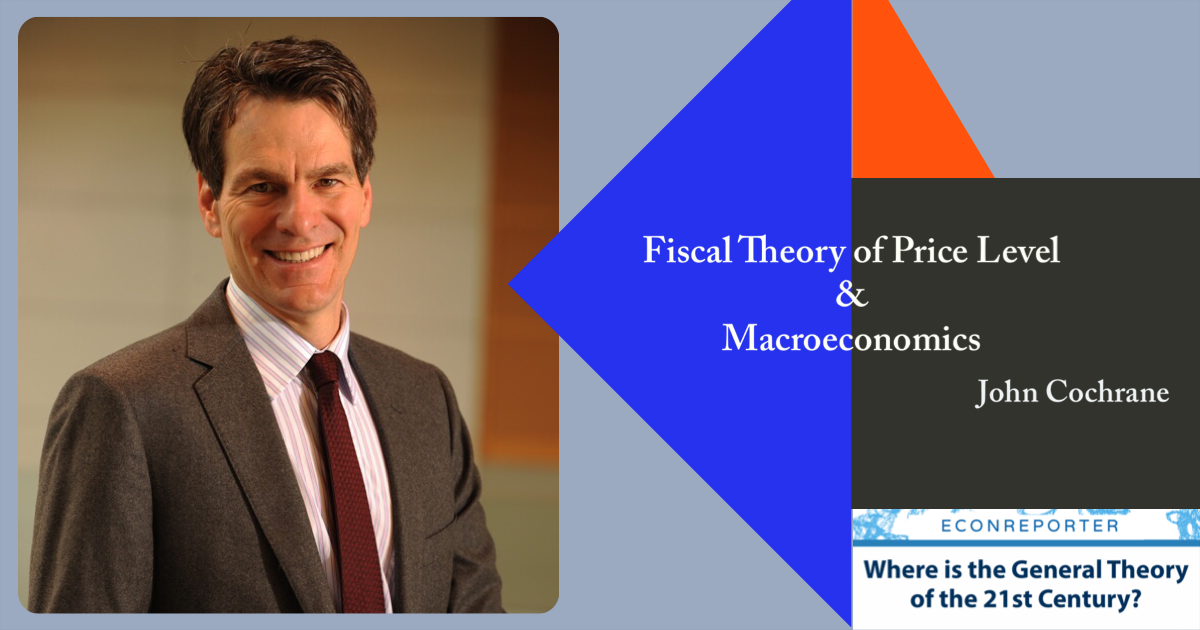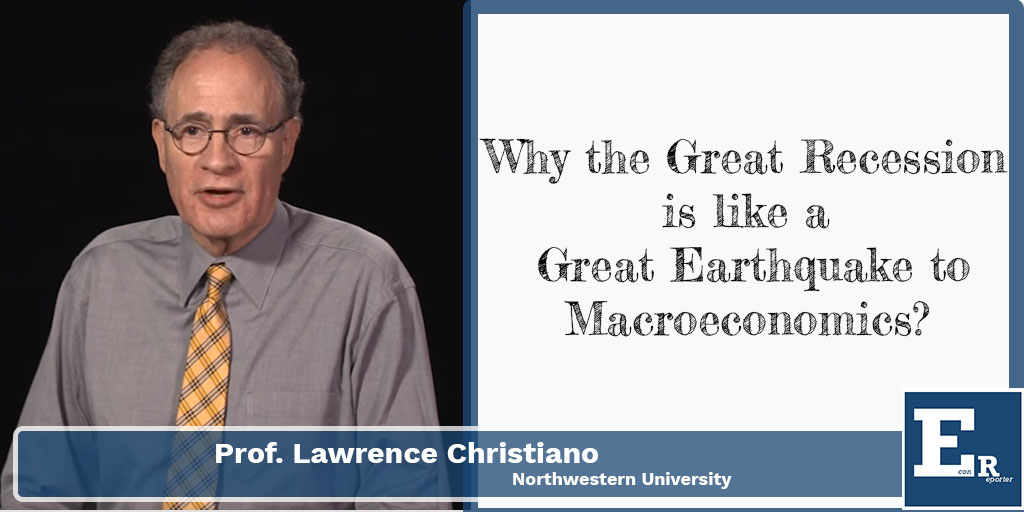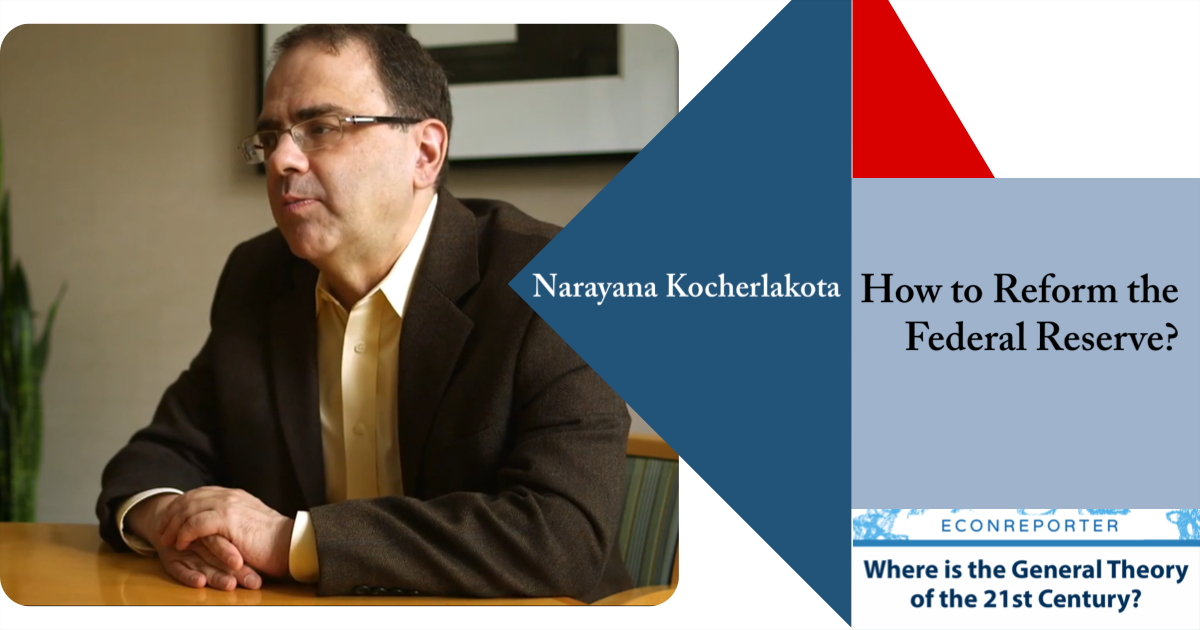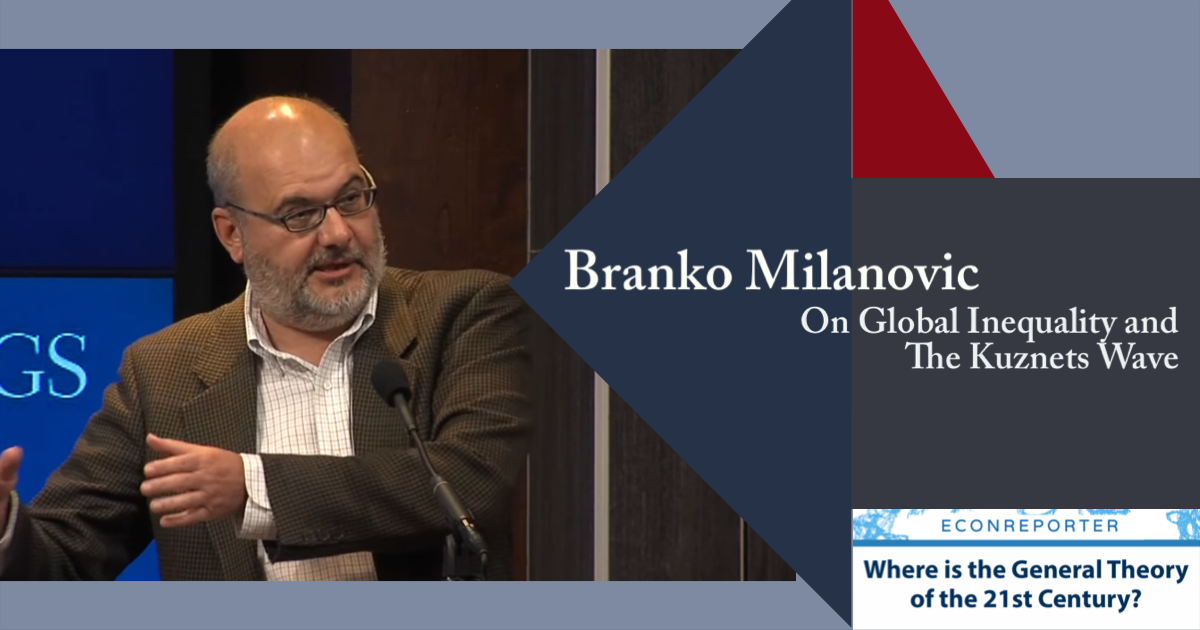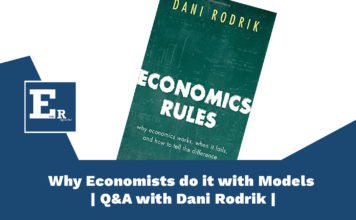This is part of our interview series “Where is the General Theory of the 21st Century?” In this article, we continue our discussion with Professor John Cochrane, Senior Fellow of Hoover Institution, Stanford University. He talks about Fiscal Theory of Price Level and how can we apply this theory on the current macroeconomy. You might first read the part I of this interview here before continuing.
You can also find a streamlined version of this interview in the Winter 2017 issue of Hoover Digest
“A Thousand Things Going Wrong”
Hoover fellow John H. Cochrane surveys the effects of economic reality on economic theory.
For more “Where is the General Theory of the 21st Century?“, please follow our series via RSS or our twitter
The transcript below has been edited for length and clarity. All mistakes and miscommunications are ours.
Q: Econreporter C: John Cochrane
Q: A few months ago you held a conference “Next Steps for the Fiscal Theory of the Price Level” and invited several elite economists to discuss the FTPL. It seems that FTPL is getting much more attentions. What’s the difference this time? Actually, I can imagine that FTPL is being heard much by more people in recent years, maybe even some of the Fed officials starts to wonder about FTPL.
People are naturally conservative. If you have an old theory like standard ISLM, you don’t want to abandon it. If you are a policy type people, you would say, “Alright, you know, all you guys are whining about the Fed, but it kinds of working pretty well day today, so I am gonna ignore all that.”
I think the moment has come when they realize that the standard of thinking just can’t work anymore. More deeply, I think we are all realizing the view that the central bank is tremendously powerful is not tenable anymore. People used to think central bank can just set the rate of inflation. Well, central banks have been desperately trying to set the rate of inflation for eight years now and get nowhere.
This is an interesting change indeed. It is now standard to think that central banks are the most important. Monetary stimulus! They set inflation! They stop the recession! They are the captain of the ship with the hand right on the rudder steering the economy! But actually, these are very new ideas!
In the 1960s, the central bank we think of it is just a bureau, minister or something of the sort. They are a bunch of guys with green eye shed, who worry about the payment system. At the same time, standard Keynesian Economics was all about fiscal policy, investment multiplier, confidence, etc. Nobody thought of central banks. Then Milton Friedman came along and said: “No, fiscal policy is kind of irrelevant. Central banks are the truly immensely powerful thing.” So that idea has only been with us since 1968.
I think central bankers are now realizing that central banks are much less powerful than we thought they were. There are only so much they can do, and now we got to look around to figure out why is it that they are so much less powerful than everybody thought.
FTPL and Neo-Fisherian ideas, which pop out of modern economics models if you let the equations sing what they want to sing, give a good account of the limits of the central bank’s power. So I think that’s why people are naturally turning to them. Central Bankers tried lowering interest rate, but that didn’t do any good. They tried massive quantitative easing, and that didn’t do any good neither.
Hum, maybe we need a new theory here…
Q: In your interpretation of FTPL, you put the emphasis on the discount rate, why?
C: Let’s take the puzzle I raised but didn’t answer: what’s going on with Japan? Why is it that people are willing to hold Japanese government debt even though the debt to GDP ratio is huge, and they are still running a deficit. If fiscal deficit causes inflation, where is the hyperinflation in Japan?
Similarly, let’s think about the whole world. When we ran into the Recession in 2008, every country in the world ran into huge deficits, deliberate deficit, big stimulus plan. Yet we didn’t have inflation, we have deflation. So what’s going on with that?
Now, when you think about the episode, I think the answer is obvious. In 2008, everybody wanted to hold government bonds because they want to get out of stocks and other stuff that they were really afraid of. So if you ask them: “Why are you holding government bonds?” The answer is not, “Oh! I think I am gonna to earn a great return.” It’s rather: “I am happy to hold government bonds. I understand the rate of return is low on these government bonds, but there is no risk with them, and I am happy to take a low rate of return in order to avoid the risk.” So the rate of returns people is willing to accept on government bonds had plummeted. People were happy to hold government bonds with the very low-interest rate.
Ultimately, inflation is the value of government bond. The way governments bond can lose value is the price level goes up. This is where my Finance background goes into monetary economics. Remember, the stock price is determined not just by earnings of the company but also by the rate of return that people demanded to hold it. If people are willing to hold the stock at a lower rate of return, then the price goes up even the earning haven’t changed. The same is true for government bonds and the Fiscal Theory of Price Level. If people become scared and are willing to hold government bonds at a low rate of return, that’s gonna cause deflation, even if the government deficit haven’t changed or even if the deficit gets worse.
To understand the stock price variation over time, especially over the business cycle, it’s vitally important to understand how risk premium and the rate of return vary over the business cycle. That’s everything.
So it should be no surprise that to understand the inflation, which is the value of government debt over the business cycle, don’t look at a deficit so much, look to people’s risk aversion and how much rate of return they demand to hold government debt. Then it all make sense.
Stocks goes up because people are willing to hold stocks at a low rate of return. You get inflation in booms because people want to move out of government debt and into stocks. They are willing to hold that risk. They are getting out of government debt and that causes inflation.
When we go into recession, everybody got scared. They want to get out of stocks. They want to go into government debts. So the stock prices go down and the price of government debt goes up, meaning interest rate fall, bond prices rise and inflation falls as well.
All those are being driven not by the deficit, but by the rate of return and the risk premium people demand in order to hold stocks versus government bonds.
Q: So it is not the nominal or real rate that matters the most, maybe it is the risk premium that matters the most, as it would change the rapidly. Am I right? If this is the case, does it mean that policy maker is powerless?
C: Yeah, this is a fundamentally different view of recession. In our previous conversation, you are saying that: “This is an old theory, John! What take you so much time with the old theory?”
Well, the theory said that inflation rate come fundamentally from the value of government debt. The value of government debt is the present value of future surpluses. How do you take that to the data though?
Present value has a discount rate, and what discount rate do you use? It turns out, to think about the data, the variation in that risk premium or discount rate over time is the really important thing. Well, how do you measure that? All the sudden it becomes difficult.
You are exactly right. Policymakers, especially central bankers, might be able to control the short-term rate of government bonds. But they have very little control over risk premium.
When everyone got scared, everyone got scared. Mostly, central bankers can control risk premium just a bit by not screwing things up. But when policies get chaotic, when the Treasury Secretary gets on TV and said silly things on the eve of the financial crisis, they can cause risk premium to skyrocket.
There is a lot of talks about low-interest rate boosting risk premium, but let me be charitable and call that “new economics”. There is very few well-understood mechanism by which the policymaker can change risk premium. They try to buy securities, try to get everyone to buy stock to lower the risk premium. That just last for a while but then it blows up, stocks fall anyway.
That’s where I think of the danger of inflation. Inflation seems very low right now, where is the danger of inflation? The danger is the rise in the risk premium. It could easily happen if some government somewhere tries to borrow a lot more than it can pay back.
For example, Italy could blow up, China can get into trouble. All it takes is for people to think, “You know, I think I want to get out of government bonds for a while and get into real assets like stocks, real estates, or commodities.” Then you get the flight from government debt, risk premium goes up, and inflation spikes up. None of this the central bank can do much about that.
Q: Is there an international dimension of FTPL? What I would like to ask it that, for example, Professor Rajan has been proposing an international coordinated monetary regime. In terms of FTPL, do we need to consider the international spillovers? And do we need international coordinations?
C: There are few parts to answer this question. First, what is the international implication of FTPL? The big one is, when you think about exchange rate changes, FTPL will lead you to think about the fiscal stance of different countries and the risk associated with holding those countries’ debt, as oppose to just thinking about the monetary policies.
Certainly, currencies crash. Like the East Asian crisis in the late 1990s hs been traced back to fiscal events in those countries. Their governments were backing up their banks, so when the banks got in trouble, so did the governments.
Now, when a country does better, its exchange rate appreciates. Why is that? Normally economists think in terms of just central banks and money. But when the country does better, it means the government is more able to pay off its debt, so it is very natural for a fiscal theory to say that higher productivity raises exchange rates. A better economy will lead to a stronger exchange rate, which is actually a hard thing to get out of standard monetary economics.
You just mentioned coordination, and I found Rajan fascinating on this. Just gets us a little bit out of fiscal versus monetary, but think about how our currency and monetary affairs should be organized.
I am not sure why every small country needs its own currencies, and why exchange rates need to fluctuate so much. What Raghuram thought was kind of edging in that direction. Fixed exchange rate might not be such terrible thing. Everybody seems to be going in the opposite direction now and think that the Euro was the cause of all ill. I think the euro is great! In fact, as we think about our monetary/fiscal arrangements going forward, I look forward to a day when we divorce the price level from the fiscal fortune of a particular country.
We have been talking so far about just why are inflation and exchange rate as they are, given the world’s institutional setup. But maybe we should think about a better institutional setup and better kinds of currency. Maybe we all shall be using Bitcoin or we should all adopt the Euro. The basic idea of the euro is that a country where the currency is held by a central bank and were supposed to be divorced from the deficit and debt of an individual country. That’s a basically good idea.
The meter, which is the standard of length, is the same for all countries. Nobody thinks it is a good idea for Hong Kong to shorten the meter when it needs to stimulate demand and help out the locals a little bit, so the locals don’t have to pay so much to get a suit. But we still think that it’s a good idea to change our standard of value every time a local business need a little bit of a boost. I am profoundly skeptical about it.
I think Raghuram is edging his way. International coordination is the first step for a fixed exchange rate, which is the first step to having a lot fewer currencies and a lot more stable measures of value that are not deeply entwined with government finances. I think that government finances are gonna be real trouble for the next twenty or thirty years. If we could find a way for our government to get out of their fiscal messes, without causing a big inflation, that would be lovely.
Q: What is the FTPL interpretation on Helicopter Money?
C: Again, I don’t think creating inflation is a good idea. But if you want to create inflation, how do you create inflation? We can separate again what’s a good idea from how a model work.
I think of helicopter money as a prime case for the FTPL because helicopter money is a fiscal operation. People think that the central banks print money and give it out. It does not. The central banks always buy bonds. It takes in something in exchange for giving something else.
Now it’s easy for everyone to see why central banks might be powerless. You have a hundred dollar government bond in your pocket, the central bank said: “Give me that bond and I will hundred dollars in cash.” Why is that suppose to make me go out and spend more money? Now, at zero interest rate, it’s almost the same as the central bank say: “Give me that 20 dollar bill and I will give you two five and a ten.” That’s what conventional open market operations are, no wonder they don’t do any good.
Helicopter Money is just to give you the 20 dollar bill and you can do whatever you want. You can kind of see why that get people to spend more money. But that is fiscal policy, and the way helicopter drop would happen in the US, and in any other countries, is the treasury would borrow money and write checks to voters. Then the central banks would buy up the resulting bonds. It’s fiscal policy and there are excellent reasons we don’t want our central banks writing checks to voters. That’s just, politically, the sort of thing probably Treasury and Parliament do not want independent central bankers to do.
Would it work? Supposed the helicopter drops everywhere 100 dollar bills, everyone gets a free hundred dollar bill. But at the same moment the government said, “By the way, tomorrow taxes are going up. Everyone has to pay a hundred more tax.” No one is gonna spend that. They are just gonna sit on the hundred dollar bill because they have to pay more taxes tomorrow.
So what helicopter is all about? It’s a psychological device, for committing the government to say, “We are gonna drop this money and we are not gonna raise taxes to soak it back up again.” When the government sells government bond, everybody understands I am giving you pieces of paper today, but we are gonna raise taxes tomorrow to pay back these government bond. How is the helicopter drop different from just selling government bond, that’s the key.
Suppose our government has been so good in building up a reputation that they pay off their debt. If they were to drop money or government bonds from helicopters, it’s not obvious that people would believe that that will be out there forever. The key to creating inflation is to make people really believe that the government is not going to raise taxes, or cut spending, to take care of its deficit.
Then you can see the problem. Can you get a little of inflation by this way? Once you destroyed your reputation for paying back your debt, and people want to get rid of your bonds and your cash, because they worry that they won’t get payback. Can you do that just a little bit? Or is this like people saying: “I am just gonna smoke one cigarette a month because it makes me feel good.”
Once your reputation is gone, how do you control that to just 2% inflation? Especially when our governments got a huge debt?
Q: And I can see the risk premium will rise rapidly, and It won’t be good.
C: Right! So the government said, “We are just gonna to print money and hand it out to voters in order to spend it. We are committed to being irresponsible and we want inflation to happen.” Well, once you do that, with a little bit of money, people start to look at the 20 trillion dollars of government debt and say, “Hum…Maybe I better get rid of all of this stuff quick.”
Q: I am under the impression that you might not be a fan of New Keynesian economics. But it seems obvious that New Keynesian Economics has been dominating economic policy making in the recent decade. Do you think New Keynesian Economics is still useful in the current economic environment?
C: Actually, I am quite a fan of New Keynesian Economics!
Let me explain, I am not a fan of old Keynesian economics, like the static ISLM curves that we all got to drag through in undergraduate classes if we manage to stay awake that long. There is just no economics in it. It has been repudiated so much by both the data and theoretical incoherence. But that’s what most of the policy world still use.
New Keynesian economics, just to clarify, is well written down economics models. They follow the rules of economics. They impose budget constraints. They do things right. They introduce some stickiness in prices.
I would say I like the New Keynesian Economics up till the 90 percent point. You need one last equation to finish up the model. I would prefer to use the FTPL to finish up the model and explain where the inflation comes from. But people choose to throw away this equation. Instead, we assume that central bankers can threaten to blow up the world if all but one thing happen.
Technically speaking, there are multiple equilibria in the model. How do you choose among them? The standard solution of New Keynesian model says: “If anything but 3% inflation happens, everybody would believe the Fed would take us to hyperinflation.” That just seems nutty to me. There’s an alternative here. Just put the FTPL in.
So I like 90% of the structure of New Keynesian Models, except for this last little technical detail. Just put the FTPL equation back in, get rid of this assumption that the Fed will blow up the world if we don’t do what they like us to do. Now that changes the property of the model quite a bit, that one little assumption. But I am a fan of 99% of New Keynesian Model.
The other thing I am not a fan of is writing down equations of New Keynesian model and then writing introductions that use ISLM logics to talk about it. That’s what way too many papers do.
I am sorry. Many people sort of regard New Keynesian model as holy water, think that it’s ok to use ISLM now because Mike Woodford gave us all the equations. That’s not true. New Keynesian model, even in their pure form, behaves utterly different from old fashion Keynesian ISLM.
I just give you another example. In old fashion model, the multiplier works because the government gives you money, then you spend more and give someone else money, he spends more and give someone else money. That’s not how New Keynesian model works at all. The marginal propensity to consume is zero in the New Keynesian Model. It’s entirely the government changes the interest rate then you decide to consume today rather than tomorrow. It’s hundred percent permanent income theory, and not at all marginal propensity to consume. They do not justify ISLM thinking in any form.
Q: So New Keynesian Model plus FTPL would be perfect?
C: Who knows if it would be perfect. But I think that it is the most theoretically coherent structure to start exploring the world and see how to understand things that whether things work. Then we let the data tell us whether it is really true.
We don’t go from theoretical purity. We go from data.
>>> You can follow EconReporter via Bluesky or Google News


